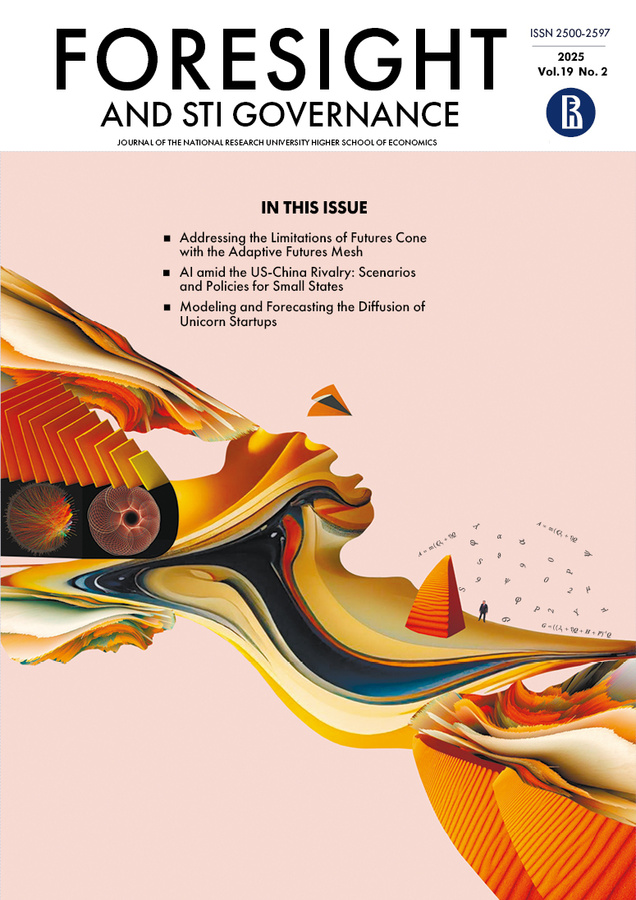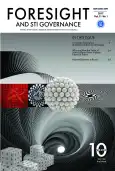Corporate Foresight in Multinational Business Strategies
- Authors: Bereznoy A.1
-
Affiliations:
- HSE University
- Issue: Vol 11, No 1 (2017)
- Pages: 9-22
- Section: STRATEGIES
- URL: https://bakhtiniada.ru/1995-459X/article/view/350321
- DOI: https://doi.org/10.17323/2500-2597.2017.1.9.22.
- ID: 350321
Cite item
Abstract
References
- Ansoff I. (1965) Corporate Strategy. New York: McGrow-Hill.
- Ansoff I. (1979) Strategic Management. London: Macmillan.
- Ansoff I., Declerck R.P., Hayes R.L. (1976) From Strategic Planning to Strategic Management. London, New York: Wiley.
- Barringer B.R., Bluedorn A.C. (1999) The Relationship between Corporate Entrepreneurship and Strategic Management // Strategic Management Journal. Vol. 20. № 5. P. 421-444.
- Bennett N., Lemoine G.J. (2014) What VUCA Really Means for You? // Harvard Business Review. Vol. 92. № 1/2. P. 27-35.
- Bereznoy A. (2015) Changing Competitive Landscape Through Business Model Innovation: The New Imperative for Corporate Market Strategy // Journal of the Knowledge Economy. 27.10.2015. P. 1-22. Режим доступа:http://link.springer.com/article/-x, дата обращения 20.07.2016. DOI:https://doi.org/10.1007/s13132-015-0324
- Berger G., Bourbon-Busset J.D., Masse P. (2008) De la Prospective: Textes Fondametaux de la Prospective Francaise 1955-1966. Paris: L’Harmattan.
- Bishop P., Hines A., Collins T. (2007) The Current State of Scenario Development: An Overview of Techniques // Foresight. Vol. 9. № 1. P. 5-25.
- Bodwell W., Chermack T. (2010) Organizational Ambidexterity: Integrating Deliberate and Emergent Strategy with Scenario Planning// Technological Forecasting & Social Change. Vol. 77. № 1. P. 193-202.
- Boyd D.K. (1991) Strategic Planning and Financial Performance: A Meta-Analytic Review // Journal of Management Studies. Vol. 28. № 4. P. 353-374.
- Bradfield R., Wright G., Burt G., Cairns G., Heijden K. (2005) The Origins and Evolution of Scenario Techniques in Long Range Business Planning // Futures. Vol. 37. P. 795-812.
- Brews P.J., Hunt M.R. (1999) Learning to Plan and Planning to Learn: Resolving the Planning School / Learning School Debate // Strategic Management Journal. Vol. 20. № 10. P. 889-913.
- Grant R.M. (2003) Strategic Planning in a Turbulent Environment: Evidence from the Oil Majors // Strategic Management Journal. Vol. 24. № 6. P. 491-518.
- Hamel G., Prahalad C.K. (1989) Strategic Intent // Harvard Business Review. Vol. 67. № 3. P. 63-76.
- Kachaner N., Deimler M.S., Saussois C. (2008) Does Your Strategy Need Stretching? Adapting Your Strategy-Development Approach to Fit Today’s Rapidly Changing Competitive Environment. Boston: The Boston Consulting Group Inc.
- Kahn H. (1962) Thinking about the Unthinkable. New York: Horizon Press.
- Kaplan S. (2012) The Business Model Innovation Factory: How to Stay Relevant When the World is Changing. Hoboken, NJ: Wiley.
- Kaplan S., Beinhocker E.D. (2003) The Real Value of Strategic Planning // MIT Sloan Management Review. Winter. 15.01.2016. Режим доступа:http://sloanreview.mit.edu/article/the-real-value-of-strategic-planning/, дата обращения 19.07.2016.
- Kukalis S. (1989) The Relationship among Firm Characteristics and Design of Strategic Planning Systems in Large Organizations // Journal of Management. Vol. 15. № 4. P. 565-579.
- Learned E.P., Christensen C.R., Andrews K.R., Guth W.D. (1965) Business Policy: Text and Cases. Irvin: Homewood.
- Li Y., Guohui S., Eppler M.J. (2008) Making Strategy Work: A Literature Review on the Factors Influencing Strategy Implementation. Lugano: Institute for Corporate Communication, University of Lugano. Режим доступа:http://www.knowledge-communication.org/pdf/making-strategy-work.pdf, дата обращения 18.07.2016.
- Miles I., Saritas O., Sokolov A. (2016) Foresight for Science, Technology and Innovation. Heidelberg; New York; Dordrecht; London: Springer.
- Mintzberg H. (1994a) The Rise and Fall of Strategic Planning: Reconceiving Roles for Planning, Plans, Planners. New York: Free Press.
- Mintzberg H. (1994b) The Fall and Rise of Strategic Planning // Harvard Business Review. Vol. 72. № 1. P. 107-114.
- Mootee I. (2016) The End of Strategic Planning and the Rise of Strategic Foresight. Режим доступа:http://idr.is/the-end-of-strategic-planning-and-the-rise-of-strategic-foresight/, дата обращения 20.07.2016.
- Nash D. (2013) Case Studies: Identifying Foresight Methods and Practices in American Corporate Planning. Prescott Valey, AZ: Northcentral University.
- Nicholls N. (2013) Future of Business. Режим доступа:http://www.nicknicholls.com/no-business-is-too-big-to-fail-or-too-small-to-succeed/future-of-business/, дата обращения 19.07.2016.
- OECD (2009) The Bioeconomy to 2030: Designing a Policy Agenda. Main Findings and Policy Conclusions. Paris: OECD.
- Pearce J.A., Freeman E.B., Robinson R.B. (1987) The Tenuous Link between Formal Strategic Planning and Performance // Academy of Management Review. Vol. 12. № 4. P. 658-675.
- Porter M.E. (1980) Competitive Strategy: Techniques for Analyzing Industries and Competitors. New York: Free Press.
- Reeves M., Deimler M. (2011) Adaptability: The New Competitive Advantage // Harvard Business Review. Vol. 89. № 7/8. P. 134-141.
- Rohrbeck R. (2011) Corporate Foresight: Its Three Roles in Enhancing the Innovation Capacity of a Firm // Technological Forecasting & Social Change. Vol. 78. № 2. P. 231-243.
- Rohrbeck R. (2012) Trend Analysis and Corporate Foresight. Aarhus: European Innovation Academy.
- Rohrbeck R., Battistella C., Huizingh E. (2015) Corporate Foresight: An Emerging Field with a Rich Tradition // Technological Forecasting & Social Change. Vol. 101. № 1. P. 1-9.
- Rohrbeck R., Schwarz J.O. (2013) The Value Contribution of Strategic Foresight: Insights from an Empirical Study of Large European Companies // Technological Forecasting & Social Change. Vol. 80. № 5. P. 1593-1606.
- Rohrbeck R., Thom N. (2008) Strategic Foresight at Deutsche Telekom AG. Aarhus: Aarhus University. Режим доступа:https://www.researchgate.net/publication/251861048_Strategic_Foresight_at_Deutsche_Telekom_AG, дата обращения 18.07.2016.
- Roland Berger (2013) How to Survive in the VUCA World. Hamburg: Roland Berger.
- Rosso D. (2016) International Technology Roadmap for Semiconductors Examines Next 15 Years of Chip Innovation. Режим доступа:http://www.semiconductors.org/news/2016/07/08/press_releases_2015/international_technology_roadmap_for_semiconductors_examines_next_15_years_of_chip_innovation/, дата обращения 18.07.2016.
- Ruff F. (2006) Corporate Foresight: Integrating the Future of Business Environment into Innovation and Strategy // International Journal of Technology Management. Vol. 34. № 3-4. P. 278-295.
- Ruff F. (2015) The Advanced Role of Corporate Foresight in Innovation and Strategic Management - Reflections on Practical Experiences from Automotive Industry // Technological Forecasting & Social Change. Vol. 101. № 1. P. 37-48.
- Salvatico Y.M. (2013) Addressing the GAP: Developing Corporate Foresight Through Competency Building // Kedge. 30.07.2013. Режим доступа:http://www.kedgefutures.com/addressing-the-gap-developing-corporate-foresight-through-competency-building/, дата обращения 20.07.2016.
- Slaughter R. (1997) Developing and Applying Strategic Foresight // ABN Report. Vol. 5. № 10. P. 13-27. Режим доступа:http://www.forschungsnetzwerk.at/downloadpub/2002slaughter_Strategic_Foresight.pdf, дата обращения 18.07.2016.
- Tendulkar S. (2016) The Best Way to Predict the Future is to Create It: BMW Group Redefines Automotive Excellence at Auto Expo 2016 // BusinessWire India. 03.02.2016. Режим доступа:http://businesswireindia.com/news/news-details/the-best-way-predict-future-is-create-it-bmw-group-redefines-automotive-excellence-at-auto-expo-2016/47157, дата обращения 20.07.2016.
- UNIDO (2005) Technology Foresight Manual. Vol. 1. Organization and Methods. Vienna: UNIDO.
- Vecchiato R. (2012) Environmental Uncertainty, Foresight and Strategic Decision Making // Technological Forecasting & Social Change. Vol. 79. № 3. P. 436-447.
- Vecchiato R. (2015) Strategic Planning and Organizational Flexibility in Turbulent Environments// Foresight. Vol. 17. № 3. P. 257-273.
- Vecchiato R., Roveda C. (2010) Strategic Foresight in Corporate Organizations: Handling the Effect and Response Uncertainty of Technology and Social Drivers of Change // Technological Forecasting & Social Change. Vol. 77. № 9. P. 1527-1539.
- Webb A., Baigorri M. (2013) Nokia without Handsets Follows Ericsson in Networks Focus // Bloomberg Technology, 05.09.2013. Режим доступа:http://www.bloomberg.com/news/articles/2013-09-03/nokia-without-handsets-follows-ericsson-in-networks-focus, дата обращения 18.07.2016.
- Wiltbank R., Dew N., Read S., Sarasvathy S.D. (2006) What to Do Next? The Case for non-Predictive Strategy // Strategic Management Journal. Vol. 27. № 10. P. 981-998.
- Wulf T., Meissner P., Stubner S. (2010) A Scenario-Based Approach to Strategic Planning - Integrating Planning and Process Perspective of Strategy. Leipzig: Leipzig Graduate School of Management.
- Yoda T. (2013) Corporate Foresight in Japan. Nomi: JAIST. Режим доступа:https://dspace.jaist.ac.jp/dspace/bitstream/10119/11745/1/kouen28_407.pdf, дата обращения 20.07.2016.
- Горбатова А. (2014) Движение от будущего к настоящему // STRF.ru. 23.07.2014. Режим доступа:http://www.strf.ru/material.aspx?CatalogId=221&d_no=82051#.V2pNg2df2Uk, дата обращения 19.07.2016.
- Соколов А.В. (2007) Форсайт: взгляд в будущее // Форсайт. Т. 1. № 1. C. 8-15.
- Третьяк В.П. (2012) Конкурентоспособность отечественных компаний и корпоративный форсайт // Экономические стратегии. № 10. C. 16-21.
Supplementary files









